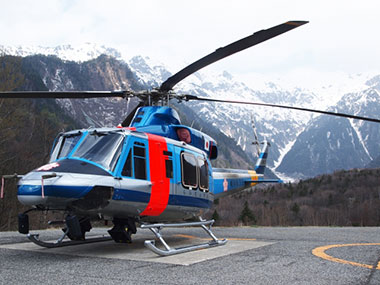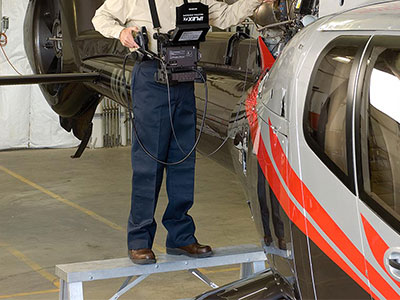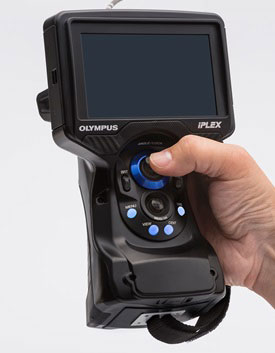
Application—Borescope inspection of helicopter main rotors
During maintenance of helicopters, inspectors use industrial borescopes to check for any damage or cracks in the strap pack located at the base of the main rotor. As the main rotor of the helicopter is located at the top part of the airframe, inspectors often use scaffolding or a platform to access it. If the instrument is small enough, inspectors can place it on the platform or scaffolding. Sometimes they rest the instrument on top of the airframe, but depending on the helicopter model, there may not be enough room. Limited space often forces inspectors to hold the inspection instrument in one hand and maneuver the borescope in the other. However, holding it in one hand can be cumbersome and even painful if the instrument is heavy.

Olympus’ IPLEX G Lite videoscope in use on a platform
Solution Using the IPLEX G Lite Industrial Videoscope
Olympus’ IPLEX G Lite industrial videoscope was designed for one-handed operation. It enables inspectors to perform remote visual inspection of motor rotors in restrictive workspaces where their only choice is to hold the instrument for the entire duration.

IPLEX G Lite videoscope
- You can hold it comfortably with one hand for extended periods.
The touch screen and control unit of an IPLEX G Lite videoscope is not only lightweight but also optimally weight balanced, so the load is easier to bear. - All operations can be easily performed with one hand.
The IPLEX G Lite videoscope is equipped with ambidextrous controls that enable you to perform all operations with one hand, including image recording/playing, articulating the tip of the scope, as well as other menu prompts. - The only cable is the insertion unit.
The videoscope controls are integrated into the handheld unit along with the touch-screen monitor. It is battery operated, so no power cable is required.
Conclusion
The IPLEX G Lite videoscope can be held easily with one hand during the entire duration of remote-visual inspections of helicopter rotor motors, enabling inspectors to get reliable and accurate images and results, even in the restrictive and elevated working conditions of scaffolding and platforms.


